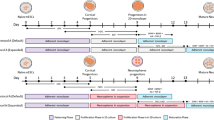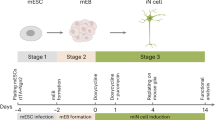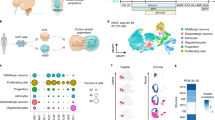Abstract
Efficient derivation of human cerebral neocortical neural stem cells (NSCs) and functional neurons from pluripotent stem cells (PSCs) facilitates functional studies of human cerebral cortex development, disease modeling and drug discovery. Here we provide a detailed protocol for directing the differentiation of human embryonic stem cells (hESCs) and induced pluripotent stem cells (iPSCs) to all classes of cortical projection neurons. We demonstrate an 80-d, three-stage process that recapitulates cortical development, in which human PSCs (hPSCs) first differentiate to cortical stem and progenitor cells that then generate cortical projection neurons in a stereotypical temporal order before maturing to actively fire action potentials, undergo synaptogenesis and form neural circuits in vitro. Methods to characterize cortical neuron identity and synapse formation are described.
This is a preview of subscription content, access via your institution
Access options
Subscribe to this journal
Receive 12 print issues and online access
$259.00 per year
only $21.58 per issue
Buy this article
- Purchase on Springer Link
- Instant access to full article PDF
Prices may be subject to local taxes which are calculated during checkout





Similar content being viewed by others
References
Lindvall, O. & Kokaia, Z. Stem cells in human neurodegenerative disorders—time for clinical translation? J. Clin. Invest. 120, 29–40 (2010).
Takahashi, K. & Yamanaka, S. Induction of pluripotent stem cells from mouse embryonic and adult fibroblast cultures by defined factors. Cell 126, 663–676 (2006).
Takahashi, K. et al. Induction of pluripotent stem cells from adult human fibroblasts by defined factors. Cell 131, 861–872 (2007).
Yu, J. et al. Induced pluripotent stem cell lines derived from human somatic cells. Science 318, 1917–1920 (2007).
Park, I.H. et al. Disease-specific induced pluripotent stem cells. Cell 134, 877–886 (2008).
Ebert, A.D. et al. Induced pluripotent stem cells from a spinal muscular atrophy patient. Nature 457, 277–280 (2009).
Lee, G. et al. Modelling pathogenesis and treatment of familial dysautonomia using patient-specific iPSCs. Nature 461, 402–406 (2009).
Yagi, T. et al. Modeling familial Alzheimer's disease with induced pluripotent stem cells. Hum. Mol. Genet. 20, 4530–4539 (2011).
Shi, Y. et al. A human stem cell model of early Alzheimer's disease pathology in Down's syndrome. Sci. Transl. Med. 4, 124ra29 (2012).
Israel, M.A. et al. Probing sporadic and familial Alzheimer's disease using induced pluripotent stem cells. Nature 482, 216–220 (2012).
Devine, M.J. et al. Parkinson's disease induced pluripotent stem cells with triplication of the α-synuclein locus. Nat. Commun. 2, 440 (2011).
Shi, Y., Kirwan, P., Smith, J., Robinson, H.P. & Livesey, F.J. Human cerebral cortex development from pluripotent stem cells to functional excitatory synapses. Nat. Neurosci. 15, 477–486 (2012).
Rakic, P. Evolution of the neocortex: a perspective from developmental biology. Nat. Rev. Neurosci. 10, 724–735 (2009).
Hill, R.S. & Walsh, C.A. Molecular insights into human brain evolution. Nature 437, 64–67 (2005).
Watanabe, K. et al. Directed differentiation of telencephalic precursors from embryonic stem cells. Nat. Neurosci. 8, 288–296 (2005).
Gaspard, N. et al. An intrinsic mechanism of corticogenesis from embryonic stem cells. Nature 455, 351–357 (2008).
Eiraku, M. et al. Self-organized formation of polarized cortical tissues from ESCs and its active manipulation by extrinsic signals. Cell Stem Cell 3, 519–532 (2008).
Au, E. & Fishell, G. Cortex shatters the glass ceiling. Cell Stem Cell 3, 472–474 (2008).
Chambers, S.M. et al. Highly efficient neural conversion of human ES and iPS cells by dual inhibition of SMAD signaling. Nat. Biotechnol. 27, 275–280 (2009).
Bibel, M. et al. Differentiation of mouse embryonic stem cells into a defined neuronal lineage. Nat. Neurosci. 7, 1003–1009 (2004).
Siegenthaler, J.A. et al. Retinoic acid from the meninges regulates cortical neuron generation. Cell 139, 597–609 (2009).
Kim, D.S. et al. Robust enhancement of neural differentiation from human ES and iPS cells regardless of their innate difference in differentiation propensity. Stem Cell Rev. 6, 270–281 (2010).
Amit, M. et al. Clonally derived human embryonic stem cell lines maintain pluripotency and proliferative potential for prolonged periods of culture. Dev. Biol. 227, 271–278 (2000).
Marchetto, M.C. et al. A model for neural development and treatment of Rett syndrome using human induced pluripotent stem cells. Cell 143, 527–539 (2010).
Brennand, K.J. et al. Modelling schizophrenia using human induced pluripotent stem cells. Nature 473, 221–225 (2011).
Acknowledgements
We thank all members of the Livesey group for feedback on the practical details of the protocol reported here. Y.S. was supported by a Biotechnology and Biological Sciences Research Council Dorothy Hodgkin Studentship. P.K. was supported by the University of Cambridge/Wellcome Trust PhD Programme in Developmental Biology. This research benefits from core support to the Gurdon Institute from the Wellcome Trust and Cancer Research UK and grants to F.J.L. from the Wellcome Trust and Alzheimer's Research UK.
Author information
Authors and Affiliations
Contributions
All authors contributed to the writing, editing and testing of this protocol.
Corresponding author
Ethics declarations
Competing interests
The authors declare no competing financial interests.
Rights and permissions
About this article
Cite this article
Shi, Y., Kirwan, P. & Livesey, F. Directed differentiation of human pluripotent stem cells to cerebral cortex neurons and neural networks. Nat Protoc 7, 1836–1846 (2012). https://doi.org/10.1038/nprot.2012.116
Published:
Issue Date:
DOI: https://doi.org/10.1038/nprot.2012.116
This article is cited by
-
CUL4B mutations impair human cortical neurogenesis through PP2A-dependent inhibition of AKT and ERK
Cell Death & Disease (2024)
-
WNT signalling control by KDM5C during development affects cognition
Nature (2024)
-
Flexible, scalable, high channel count stereo-electrode for recording in the human brain
Nature Communications (2024)
-
Establishing extended pluripotent stem cells from human urine cells
Cell & Bioscience (2023)
-
Insight into muscle stem cell regeneration and mechanobiology
Stem Cell Research & Therapy (2023)
Comments
By submitting a comment you agree to abide by our Terms and Community Guidelines. If you find something abusive or that does not comply with our terms or guidelines please flag it as inappropriate.



